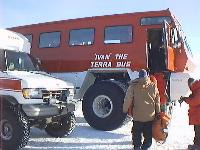Antarctic Vehicles
Created | Updated Feb 10, 2005

Antarctica, as most anyone could tell you, is a harsh continent. There are no paved roads and less than 1% of the continent is not covered by snow and ice. To cope with this situation, there are a large variety of specialized transport options. It is important to know the differences between them to avoid looking like a FNG. (the NG stands for New Guy!)
Plain old pickup trucks and Vans
In McMurdo Station there are a large number of plain new and old pickup trucks and vans. The bare rock and gravel of McMurdo Station makes these vehicles practical, and since they are largely unmodified stock vehicles and therefore inexpensive, they represent the majority of vehicles on station. All of the old vans and trucks sport oversized tyres to better cope with summer roads on the ice shelf and fast ice. Many of the new trucks do not have oversized tyres. It should be an interesting summer.
Deltas.
These are large articulted trucks with huge tyres reminiscent of monster tucks. They are mostly used to haul cargo to and from the airports. Occasionally they haul passengers over the sea ice to Cape Evans to see Scott's hut. |
'Ivan' the Terra Bus.
It looks much like a city bus with monster truck tyres, it is mostly used to haul passengers to the airport and Cape Evans. |
Tracked Vehicles
Challengers.
Imagine a bulldozer with rubber tracks and no blade. That is a Challenger, built by Caterpiller they are the largest tracked vehicles on station aside from the Caterpillar D-9 bulldozers. Challengers are often used on traverses across the continent as they can pull an astonishing number of trailers. |
Sprytes.
Made by the Thiokol Corporation, these tracked vehicles are roughly the size of a minivan. They are loud and slow and prone to breakdown. If you can, avoid using them. |
Tuckers.
The archetypical Tucker Sno-Cat. Often seen as groomers at older ski resorts. Old and more or less reliable. Also used on traverses. Recognizable by their long snout and four tank treads. |
Nodwells.
Old. Big. Slow. Versatile. The Search and rescue team uses one to transport students to snow school. Two of these have been converted to fire engines for use at the Ice runways. Two more articulated ones were purpose built as fire engines. |
Hagglunds.
The Hagglunds tracked vehicle is the size of two minivans with an articulated link between them. They are bristling with antennas and using GPS and radar, can operate in whiteout conditions. These are the primary vehicles of Search and Rescue for the US and Kiwi programs. |
Snowmobiles.
The basic unit of transport in many field camps, often used for pulling sleds now that dogs are no longer allowed on the continent. |
Pisten Bully.
Ha! Don't I wish. Pisten bullys are modern, fast, and powerful. In other words against everything the US Antarctic Program stands for. Often visible at modern ski resorts as groomers. Included just for for comparison they do not exist on the Continent.
Assorted forklifts, bulldozers and other construction equipment are found all over town as construction goes on nearly year round.
Hovercraft were tested on the ice and while they are really, really fast they require too much specialized maintenance to be practical. Lack of practicality rarely stops anything down here, so I really don't know why they aren't in use.
Tim Smith-Antarctic Correspondant Extraordinaire








